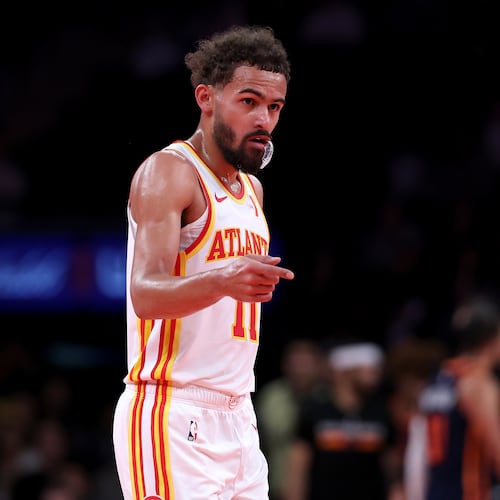After landing wrong on his left foot in Wednesday’s loss to the Knicks, Trae Young was diagnosed with a grade 2 lateral ankle sprain, or a sprain of moderate severity.
He’ll for sure miss two coming games, Friday vs. Miami and Sunday vs. Milwaukee. That’s a tough break for both Young and the Hawks, who have been plagued with injuries this season, as they jockey for position in the Eastern Conference standings down the final stretch of the regular season (as of Friday afternoon, they’re in the No. 5 spot with 13 games to go).
The biggest question on everyone’s mind: How long will Young be out? To get a general idea, the AJC spoke with Dr. Kenneth Jung, an orthopedic foot and ankle surgeon at Cedars-Sinai Kerlan-Jobe Institute in Los Angeles and foot and ankle consultant to the Lakers.
The typical recovery time for a grade 2 sprain is approximately two to four weeks, per Jung, though of course every situation varies. Sometimes it can be as fast as a week, depending on how quickly a player heals up and takes to rehab.
“I would say a lot of it depends on how quick he responds, how quick he’s able to walk on it comfortably, and then have his pain under control,” Jung said. “Grade 2, I would venture maybe at least a week, possibly two, but I would say probably two to four, at the upper range.”
Missing two weeks would mean Young would be back for the final five games of the regular season, and missing four weeks would mean he would return around May 19 (if the Hawks fall between No. 7 and 10 in the standings, they would have to participate in the play-in tournament, which will run from May 18-21, with the NBA playoffs beginning May 22). If he recovers on the fastest side of the spectrum, one week, he’d miss about four games. We’ll just have to wait and see how things develop.
But first, what does a grade 2 sprain involve?
Ligaments connect bones to bones, Jung explained, and help stabilize a joint. Think of them as a bowstring for a violin, or a cable with a bunch of fibers. A grade 1 sprain is the stretching of those fibers. With a grade 2, you have some partial tearing of some of the fibers, but overall, integrity is intact.
The first step in rehab is to get the swelling down and then work on range of motion without putting weight on it, to maintain that flexibility. Then, once Young can walk with minimal support, the next step is to strengthen the ankle.
“A lot of it, for all sprains, is symptomatic, it usually sprains up on the outer part of the ankle,” Jung said. “A lot of people see where it looks like they’ve almost got a ball on the outside of their ankle, because of the initial swelling.”
“So you try to get the swelling down, get the pain down, in order to maintain range of motion. Because what happens with the swelling and the injury itself, they get some scarring and some stiffness, and that can lead to a longer road to recovery.”
The one thing to look out for, as far as any long-term issues that can stem from a grade 2 sprain, is coming back too quickly. Ligaments stabilize joints, so if they become elongated or stretched, there can be less stability that the ligament will provide for the joint, in this case the ankle.
“If you get back too early and you roll it again, you’re at increased risk of having the ligament, healed, stretch out, which would have an increased chance of future repercussions, where the ankle will be unstable, or lax,” Jung said.
Although it’s still a tough situation and another injury for the team to overcome, this one to its star player, it seems as if Young and the Hawks were relatively fortunate this time, as there’s a path for him to return pretty quickly this season, barring any setbacks.
About the Author
Keep Reading
The Latest
Featured

